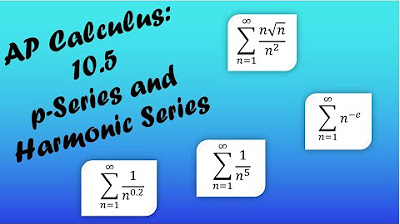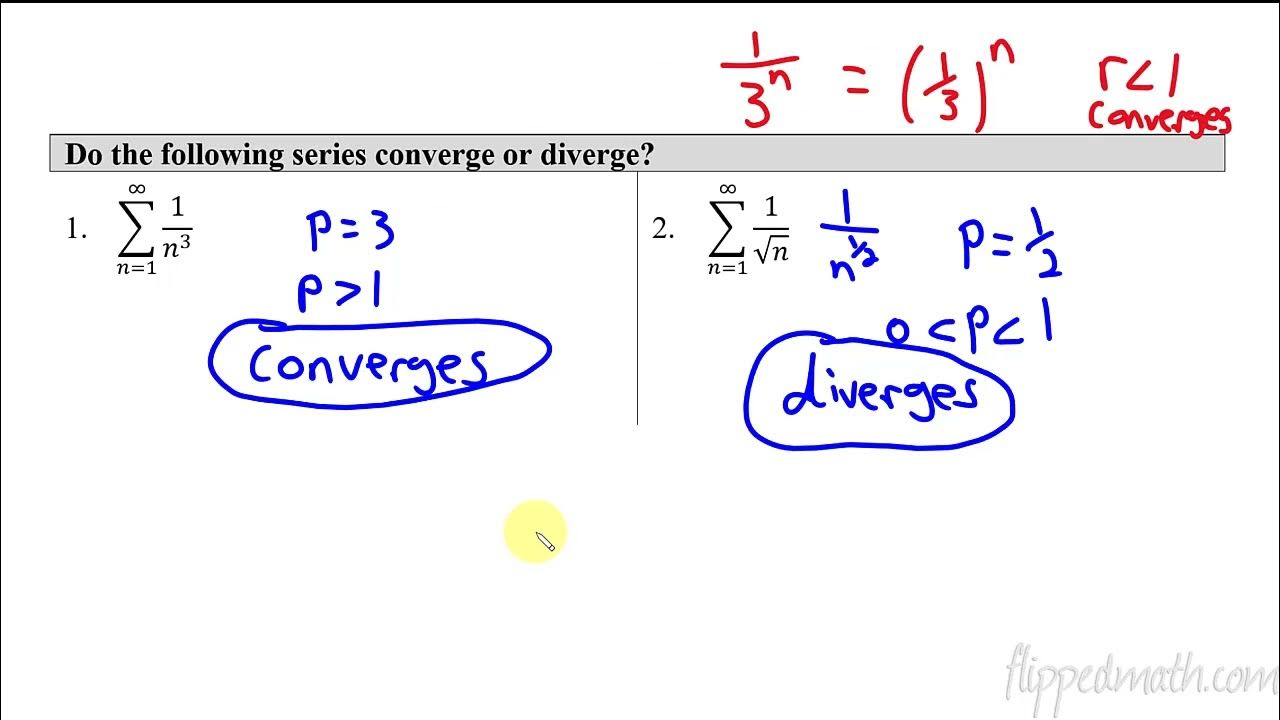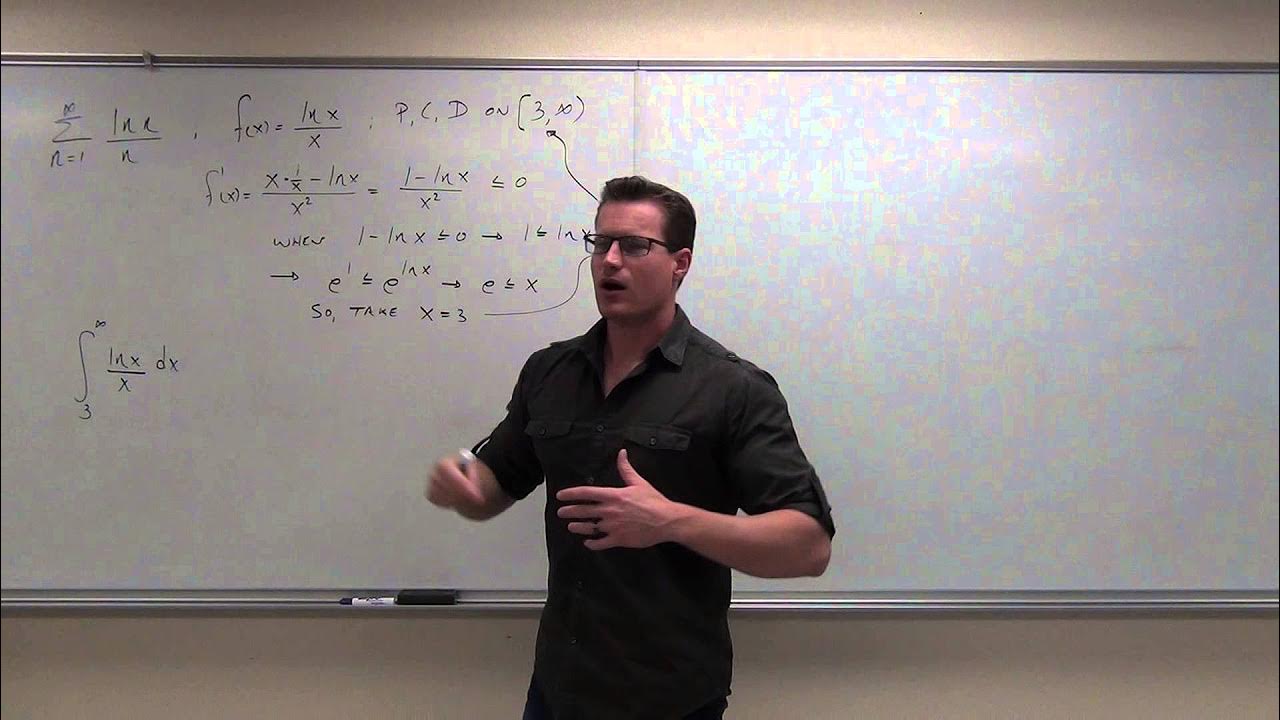Proof of p-series convergence criteria | Series | AP Calculus BC | Khan Academy
TLDRThis video explores the convergence of p-Series by comparing it to an improper integral. It visually demonstrates that a p-Series converges if and only if the integral converges. The conditions for convergence are established: p-Series converges when P > 1 and diverges when 0 < P ≤ 1.
Takeaways
- 📉 The p-Series is represented as a function 1/X^P, where P is greater than zero, and it is a decreasing function.
- 🔢 The shaded area under the curve represents the improper integral of 1/X^P from 1 to infinity.
- 🟡 The p-Series can be viewed as an upper Riemann approximation of the area under the curve, where each rectangle's area corresponds to terms in the p-Series.
- 📈 If the improper integral of 1/X^P diverges, the p-Series also diverges. Conversely, if the integral converges, the p-Series converges.
- 🔍 For P equal to 1, the integral of 1/X equals the natural logarithm of X, which diverges as X approaches infinity.
- 🧮 For P not equal to 1, the integral is evaluated as X^(1-P)/(1-P) from 1 to M, and the convergence depends on the exponent 1-P.
- ➖ If 1-P is greater than zero (P less than 1), the integral diverges because the limit of M^(1-P) as M approaches infinity is unbounded.
- ➕ If 1-P is less than zero (P greater than 1), the integral converges because M^(1-P) approaches zero as M approaches infinity.
- 📊 The integral test helps determine the convergence of the p-Series by analyzing the improper integral of 1/X^P.
- ✅ The p-Series converges only if P is greater than 1. If 0 < P ≤ 1, the p-Series diverges.
Q & A
What is the general form of a p-Series mentioned in the script?
-The general form of a p-Series is not explicitly written in the script, but it is described as a series where the terms are of the form 1/x^p, where p is a positive real number.
What is the condition for P in a p-Series by definition?
-By definition, for a series to be a p-Series, P must be greater than zero.
How is the p-Series related to the integral of 1/x^p?
-The p-Series is related to the integral of 1/x^p through the concept of convergence. The series converges if and only if the improper integral from 1 to infinity of 1/x^p dx converges.
What is the significance of the shaded area under the curve in the visualization?
-The shaded area under the curve represents the integral from 1 to infinity of 1/x^p dx, which is used to visually assess the convergence of the p-Series.
What is meant by an 'upper Riemann approximation' in the context of the p-Series?
-An 'upper Riemann approximation' refers to the approximation of the area under the curve by summing the areas of rectangles that are above the curve, which in this case are the first terms of the p-Series.
How does the p-Series compare to the area under the curve?
-The p-Series is initially greater than the area under the curve because it covers more than the actual area with the rectangles. However, if you add the first term of the p-Series to the area under the curve, the p-Series becomes less than this sum, acting as a lower Riemann approximation.
What happens if the improper integral of 1/x^p diverges?
-If the improper integral of 1/x^p diverges, meaning it does not converge to a finite value, then the p-Series, which is greater than this integral, will also diverge.
What is the special case when P equals one in the context of the integral?
-When P equals one, the integral from 1 to M of 1/x becomes the natural logarithm of M, minus the natural logarithm of 1 (which is zero), simplifying to just the natural logarithm of M.
How does the convergence of the integral affect the convergence of the p-Series?
-The convergence of the p-Series is directly tied to the convergence of the integral. If the integral converges to a finite value, then the p-Series must also converge. Conversely, if the integral diverges, the p-Series will also diverge.
What conditions determine the convergence of the integral of 1/x^p?
-The integral of 1/x^p converges when P is greater than one. If P is equal to one or less than one, the integral diverges.
What is the conclusion about the convergence of the p-Series based on the script?
-The p-Series converges only when P is greater than one. If P is between zero and one, inclusive, the p-Series diverges.
Outlines
📚 Introduction to p-Series Convergence
The video begins by introducing the general form of a p-Series and explores the conditions under which it converges. The instructor defines p-Series with p being greater than zero and uses visualizations to understand the convergence. The relationship between the p-Series and the improper integral of 1/x^p from 1 to infinity is established. The p-Series is visualized as an upper Riemann sum approximation of the integral's area, with rectangles representing the series terms. The instructor explains that the p-Series is greater than the area under the curve but less than the sum of the area and the first term of the series. The integral test is discussed, highlighting that the p-Series converges if and only if the integral converges.
🔍 Analyzing the Integral for Convergence
The second paragraph delves into the integral's convergence conditions. The instructor rewrites the integral and discusses two scenarios: when p equals one and when p does not equal one. For p=1, the integral simplifies to the natural logarithm of M, which diverges as M approaches infinity. For p≠1, the integral is transformed using the power rule, resulting in an expression involving M to the power of (1-p). The instructor then takes the limit as M approaches infinity to determine convergence. If 1-p is positive, the integral diverges, which occurs when p is less than or equal to one. Conversely, if 1-p is negative, the integral converges, which happens when p is greater than one. The conclusion is that the p-Series converges only when p is greater than one, and diverges otherwise.
Mindmap
Keywords
💡p-Series
💡Convergence
💡Divergence
💡Integral Test
💡Riemann Approximation
💡Improper Integral
💡Natural Logarithm
💡Power Rule
💡Limit
💡Exponent
Highlights
The general form of a p-Series is introduced, with p being greater than zero.
Visualizations are set up to understand when the p-Series converges.
The graph of Y = 1/X^p is presented, illustrating the decreasing function for p > 0.
The shaded area under the curve represents the improper integral of 1/X^p from 1 to infinity.
The p-Series is compared to an upper Riemann approximation of the integral area.
The first term of the p-Series is equal to the area of the first rectangle in the Riemann approximation.
Each subsequent term of the p-Series is shown to cover more than the area under the curve.
The p-Series is greater than the integral and less than the integral plus one.
The divergence of the improper integral implies the divergence of the p-Series.
Convergence of the integral implies convergence of the p-Series to a finite value.
The p-Series converges if and only if the integral converges.
The integral test is discussed as a method to determine convergence or divergence.
The integral from one to infinity of 1/X^p is rewritten for analysis.
The special case of p = 1 is discussed, leading to the natural log of M.
For p not equal to one, the integral is analyzed using the power rule in reverse.
The limit as M approaches infinity of the integral is considered for different values of p.
The integral converges when p > 1, leading to the convergence of the p-Series.
The p-Series diverges when 0 < p ≤ 1, as shown by the integral's behavior.
Transcripts
Browse More Related Video

AP Calculus BC Lesson 10.5

Improper Integrals - Convergence and Divergence - Calculus 2

Calculus BC – 10.5 Harmonic Series and p-series

Worked example: Integral test | Series | AP Calculus BC | Khan Academy

Calculus 2 Lecture 9.3: Using the Integral Test for Convergence/Divergence of Series, P-Series

The Comparison Theorem for Improper Integrals | Step by Step Explanation | Math with Professor V
5.0 / 5 (0 votes)
Thanks for rating: